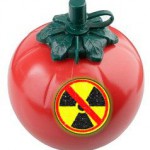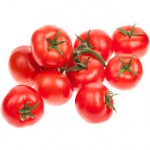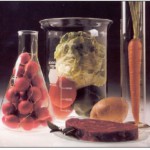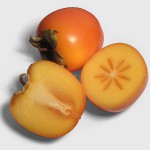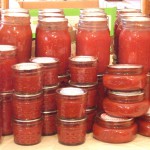
The average Australian eats 52kg of tomatoes a year
Two toxic chemicals, fenthion and dimethoate, nerve inhibiting pesticides used in Australian food production, are under review and are to be phased out. Use of these organophosphates is severely restricted overseas. Australian growers have known about potential problems with these chemicals for a long time. In fact, the review of fenthion began in 1994 and the review of dimethoate was announced in 1995, but did not actually begin until 2005. i Despite the review, Australian growers, under pressure from supermarket chains and large food corporations, chose to continue to use these chemicals because it is cheaper to do so than to establish good production practices that produce quality healthy food.
The 15 years since the reviews were announced were not used to develop positive, safe and healthy food production practices or to explore options for growing fruit and controlling fruit fly without chemicals. The status quo continued.
Now, 15 years on, as the phasing out of certain uses of these chemicals begins, the government and industry, claiming that the fenthion and dimethoate were necessary for “cost-effective” market access, are urgently pushing for another dubious post-harvest decontamination treatment to be used in their place: food irradiation.
The phase out of toxic chemicals should be a cause to celebrate – and lauded as a chance to review and improve food production practices. As it is, however, we are being offered a false choice, the swapping of one toxic industry for another dangerous one.
Chemicals versus irradiation. A no-win situation for consumers.
In 2010, the combined industry and government task force mandated with responding to the review of the uses of fenthion and dimethoate, announced work on proposals for 18 additional fruit and vegetable irradiation approvals. ii At the time, however, as part of a working plan, these were not announced to the public. While the phasing out of chemicals has had some mention in the media, the proposed use of irradiation in their place has not. With the government playing a key role in the process which proposed irradiation as the chosen “alternative” to these chemicals and also being the approver for all irradiation approvals, it is difficult to see where public opinion or consultation can have any sway.
The silence on the issue is probably more the point. Both industry and the government know that irradiation is highly unpopular with consumers and that, if given an option, many will find a problem with the “choice” we are being offered. As I write, one of Canada’s largest ever food recalls is taking place: E coli contaminated beef. An immediate push to promote irradiation as a solution is being met by cynicism of the public. An overwhelming majority of those commenting to the article on the Canadian Broadcasting Corporation website are opposed and see this as a false solution. iii In Australia, when food irradiation applications have been open for public comment, an overwhelming majority of respondents have been opposed.
And public concern is well-founded.
Irradiation is the process of exposing products to radiation, generally for sterilisation purposes. Globally, many food products have been approved for irradiation; for the most part, however, irradiation has remained a little-used process, due largely to consumer scepticism.
Numerous scientific reports have highlighted health risks associated with irradiation. Irradiation changes the molecular structure of food, forming toxic chemicals linked to genetic mutations, vitamin deficiency, immune system disorders, tumours, stunted growth and reproduction problems. iv
We applaud the restricting of use of fenthion and dimethoate. However, we question the logic of replacing one hazardous technology with another. The issue has become critical now, as the first of the newly proposed irradiation applications is underway…
Irradiated Tomatoes and Capsicums
 Over the last two years, a virtually invisible campaign has been waged to increase the amount of food irradiated in Australia – and to remove the labelling of irradiated food.
Over the last two years, a virtually invisible campaign has been waged to increase the amount of food irradiated in Australia – and to remove the labelling of irradiated food.
In 2010, the Qld Department of Primary Industries applied for the approval to irradiate persimmons. A seemingly innocuous proposal, as persimmons are not widely eaten in Australia. During the processing of the application, however, Food Standards Australia New Zealand (FSANZ), the bi-national body mandated to regulate our food industry, inserted changes to labelling and record-keeping of irradiated foods.
FSANZ’s inserted amendments signalled a “review” of mandatory labelling of irradiated food, suggesting a removal of all mandatory labelling requirements.
Alarms bells went off and a legal challenge was launched as to whether FSANZ had followed due process. The Federal Court heard the matter in November 2011 – A ruling has only just been handed down. On October 19, 2012, the Court found both that FSANZ’s actions were misleading, but they were legal. v
In the meantime, as part of the government review in to pesticide use in Australia, some uses of the organophosphates dimethoate and fenthion were earmarked for phasing out. Promoting irradiation as the alternative to these chemicals and proposing up to 18 vi new fruit and vegetable approvals, the review led to the finalising of interstate trade protocols for the use of irradiation on the Australian domestic market.
According to Qld Biosecurity, “Research projects [for irradiation] have been completed on: Tomato, capsicum, zucchini , honey dew melon, rockmelon , nectarine, strawberry, cherry, apricot , plum, peach, table grape, [and] and apple”.vii More are on the cards.
A1069
On Sept 26, 2012, Food Standards Australia New Zealand (FSANZ) announced the opening of the public consultation period for Application A1069, an application made by the Queensland government for approval to irradiate tomatoes and capsicums. The public was given four weeks to respond.
To date, herbs, spices, herbal infusions and nine tropical fruits have been approved for irradiation in Australia. Pet food, medicinal goods and seeds and grains for animal consumption may also be irradiated, though as not legally classified as “food” under Australian law, they fall under different regulations and require no labelling.
While acknowledging that irradiation may deplete vitamin and nutritional content, FSANZ has so far justified irradiation approvals on the basis that the approved food make up a minimal part of the Australian and New Zealander diet.
The table is now being turned. Up for approval are foods regularly consumed by the Australian and New Zealand public.
Australians eat tomatoes. Recent surveys have shown that 59% of Australians purchase fresh tomatoes in their weekly shopping viiiand the average Australian consumes an estimated 23kgs of tomato-based products per year. ix
Despite FSANZ’s support and proponents’ claims, irradiation has not been proven safe. In fact, no long term studies of consumption of an irradiated diet have ever been conducted
Between 2008 and 2009, approximately 100 Australian cats developed neurological disorders which led to their paralysis and, in some cases, death. The cause was the consumption of irradiated cat food. These cases are clear evidence that irradiation can have harmful, and possibly not yet understood, impacts on the food quality and on consumer’s health.
The irradiation of cat food is now banned in Australia.
 As we write, the US FDA is exploring the possibility that consumption of irradiated food has led to the deaths of 360 dogs and 1 cat and illnesses in 2,200 dogs since 2007.
As we write, the US FDA is exploring the possibility that consumption of irradiated food has led to the deaths of 360 dogs and 1 cat and illnesses in 2,200 dogs since 2007.
“These products have been extensively tested by the FDA. Labs have tested for Salmonella, metals, furans, pesticides, antibiotics, mycotoxins, rodenticides, liver toxins such as ethylene and diethylene glycol, melamine, and maleic acid, and toxic metals. None of the testing results have revealed a link between any causative agent and the illnesses and deaths. The FDA is expanding its testing to include irradiation by-products and is consulting with NASA to discuss this option.” x
Exposing food to radiation disrupts its molecular make-up, producing free-radicals and potentially producing commonly known toxic chemicals such as benzene and formaldehyde.
Ionising radiation also creates new chemicals called “radiolytic products”, some of which do not normally occur naturally in food. These have not been adequately studied. One of them, 2-ACBs, has recently been found “to promote the cancer-development process in rats, cause genetic damage in rats and cause genetic and cellular damage in human and rat cells.” x
“Irradiation destroys and disrupts vitamins, proteins, essential fatty acids and other nutrients in food – sometimes significantly. It can destroy up to 80 percent of vitamin A in eggs and 48 percent of beta-carotene in orange juice.” xii
Irradiation produces free radicals in food and has been linked to health problems such as nutritional deficiencies, immune system disorders, and genetic damage.
Another health concern is the risk of irradiation being used to mask poor production practices. Irradiation can kill most bacteria in food, but it does not remove the faeces, urine, pus and vomit that often contaminate meat or the pests, faeces, or other matter that may contaminate herbs, spices, or fruit and vegetables.
In the case of Application A1069, it is suggested that irradiation is necessary to control the spread of fruit fly, in particular Queensland fruit fly, to allow greater trade of food grown in potentially fruit fly infested areas.
Irradiation as a “phytosanitary” measure, in this case irradiating food to control fruit fly, benefits food corporations wishing to transport and trade volumes of food at the expense of the public health. Providing consumers with nutritionally depleted food and putting consumers at risk in order to protect or expand trade markets is unacceptable.
Aware that consumers, see irradiation as a “high risk, low benefit” technology, xiii FSANZ repeatedly legitimises the process by stating that a technological “purpose” xiv for irradiating has been established. While, indeed, a “purpose” – to aid in the control of fruit fly – has been established in this proposal, a technological “need” for irradiating has not.
Irradiation to control bugs.
Irradiation is not a “clean” alternative to chemicals. Irradiation for “phytosanitary control” is actually a prime example of the use of irradiation in lieu of healthy and environmentally sustainable production practices.
In 1986, Queensland DPI produced research promoting the post-harvest use of dimethoate and fenthion for controlling fruit fly on tomatoes. The research states “the insecticides dimethoate and fenthion as high volume spray (flood) treatments can disinfect tomatoes postharvest with levels of security similar to ethylene dibromide for other fruits, but with the added advantage of handling efficiency ad without phytotoxic or tainting effects.” xv
35 years on, this research has proven faulty. AVAMPA are withdrawing this use of these chemicals because they are harmful to human health. Queensland is Australia’s largest producer of fresh tomatoes and the pressure is on to maintain its markets. (VIC produces the most tomatoes for processing.) The Qld government is now presenting its own, new, unpublished research to secure approvals to irradiate tomatoes in lieu of these chemicals.
Once again, the Queensland government is getting it wrong.

Meat is irradiated in the USA
First of all, irradiation will not be used as a substitute for chemical use in food production, but will be used in conjunction with chemicals by those producers who choose to use those technologies. The chemical uses that are under question are “post-harvest” uses, not all uses. Irradiation is a “post-harvest” “treatment”. Unless a serious review of all chemical uses is conducted, or fruit and vegetables are organically grown, one can expect that fruit and vegetables irradiated after picking will have been have been grown with chemicals or other “technology”.
There is no technological need for irradiation to replace these chemicals. The fact that Australia was the only country permitting dimethoate to be used for post-harvest pest control tells us that all other markets have found other options.xvi Indeed, the task force phasing out this chemical has provided growers numerous chemical alternates to dimethoate and fenthion. Of course, non-chemical alternatives, such as organic production exist.
Finally, there is simply no need for irradiation. There are numerous alternatives to irradiation.
New Zealand quarantine will already accept Australian tomatoes if they are grown in pest-free zones, which are already feasible in most states.
While treatments may vary according to desired outcome, some of the alternatives currently in use include:
• Cold storage
• Cold treatment
• Heat/steam, vapour treatment
• Hot water dips
• Atmospheric control with oxygen, carbon dioxide or nitrogen
• Physical disinfestation, i.e. cleaning, washing
• Hygienic and safe production practices
• Pest exclusion zones
• Early harvesting
• Organic production
With numerous chemical-free and irradiation-free options for the production of food, which pose little or no health risk to the consumer, the use of irradiation as a phytosanitary measure – to protect markets –is inexcusable.
Market access – half the story
While promoted as a “tool” to protect or broaden Australian markets, irradiation is more likely to see the further destruction of local producers, with potentially devastating impact on small producers, family farms, local horticulture and agriculture and organic and alternative food production.
Irradiation is a tool of large agri-business. Approvals in Australia will not benefit Australian farmers in the long term, as any approval will also facilitate the importation of the approved irradiated foods from overseas markets, where food can typically be produced more cheaply. Imports are already playing a key role in the demise of Australia’s tomato – a fruit now proposed for irradiation.
Tomatoes are a perfect case in point. Since 2007, tomato imports have reportedly increased 40%xvii, due to poor production levels in Australia, the rising price of the Australian dollar, higher labour costs in Australia, and a legal challenge upholding market access due to international trade agreements. xviii As it stands, only 2 out of 10 cans of tomatoes sold in Australia are locally made. xix
Irradiation, therefore, will not provide the solution to what is causing the market’s demise: market saturation and competition created by large food corporations and supermarket chains.
In a move to increase output and lower production costs, Australia is already seeing its tomato industry move to large hot house style production, which has brought devastating impacts to smaller growers – closing Queensland (and therefore Australia’s) largest tomato producer, SP Exports.
Ironically, in this case, for the consumer, there is a potential silver lining to this move. Hot houses are just one example of an infrastructure that could be put in place that eliminates or lowers the probability of fruit fly infestation in crops. If seized upon, moving to this type of production could see hot houses used as pest exclusion zones – or pest free areas- eliminating the need for other fruit fly control such as pesticides or irradiation altogether.
In the long term, it would be in the Australian farmer’s interest to take this opportunity to use alternatives to chemicals and reject irradiation at the same time. If public perception alone is not enough to deter producers from this technology, the threat of increased competition from cheaply produced irradiated imports should.
Proponents suggest that the consumer should decide.
Choice?
 Unfortunately for the consumer, the government has also signalled its intention to review and remove mandatory labelling of irradiated foods. So far irradiation approvals in Australia and New Zealand have been marketed as offering consumers greater food options. However, the reality is that most of what is currently irradiated is not labelled, what is labelled is labelled poorly and the government is now using false logic to push for a removal of all labelling.
Unfortunately for the consumer, the government has also signalled its intention to review and remove mandatory labelling of irradiated foods. So far irradiation approvals in Australia and New Zealand have been marketed as offering consumers greater food options. However, the reality is that most of what is currently irradiated is not labelled, what is labelled is labelled poorly and the government is now using false logic to push for a removal of all labelling.
In 2011, the Blewitt Review of food labelling in Australia suggested that as irradiation was not a new technology, irradiated food no longer required labelling. Claiming that irradiated food had been on the market for over 30 years and that irradiated food is safe, the Review questioned the need for labelling. The federal government, taking this on board has indicated that it will request FSANZ review labelling requirements within the next two years.xx
The rationale is based on intentionally perpetuated marketing myths about irradiation and is truly disingenuous when looking at the Australian and New Zealand situation.
Consumer surveying conducted for FSANZ , as well as reports FSANZ has reviewed, have repeatedly found that irradiation is a little known process. The use of technology that is unfamiliar to the public is normally a rationale to label the process.
While irradiation technology has been under development since the early days of the nuclear age, irradiated food has not been on the market in Australia for 30 years. In fact, a huge consumer campaign against irradiation in the 1980s saw a 10-year moratorium placed on food irradiation.
The moratorium was lifted in 1999, with little public awareness. Australia and New Zealand’s first approval, for herbs, spices and herbal infusions was in 2001, with approvals for nine tropical fruits in 2003. However, outside a small amount of irradiated Australian mangoes and lychees on the New Zealand market, irradiated food has hardly found its way on to the Australian or New Zealand market.
Interstate trade protocols for the sale of irradiated fruit on the Australian domestic market were only finalised this year, in 2012.
These facts make it clear that irradiated food has not been widely available to the Australian or the New Zealand public. Any suggestion that irradiated food has wide acceptance with the Australian and New Zealand public is unfounded. Any claim that Australians and New Zealanders have 30 years of safe consumption of irradiated food is completely untrue.
As stated earlier, any claim that there are 30 years of safe consumption of irradiated food anywhere can also not be scientifically verified as no long-term research on the consumption of irradiated food have been completed. The claim that irradiated food has been proven safe is a marketing statement, not a fact.
It is disappointing that the government and irradiation proponents are simultaneously pushing to expand the irradiated food industry and remove labelling of irradiated food.
Though irradiation has a longer history in other countries, international food regulations require that irradiated food be labelled. Our English-speaking trading partners, the USA, UK and Canada all have more stringent guidelines than currently are in place in Australia. Australian and New Zealand labelling regulations should be made to equal or better than our partners. Any weakening of the current regulations would be a cynical attempt to push through unwanted, unknown technology while denying the consumer the right to choose.
Whose science?

The ‘science’ being relied upon is not independent of the industry
Australians and New Zealanders expect our food regulator to be scrupulous, stringent and non-biased in their assessment of food matters. It is clear from research that the public have faith in the government to be looking after public interest.xxi It would be expected that FSANZ adhere to internationally recognised standards of peer-review for science it relies upon when making decisions and present relevant science with honesty and integrity.
Unfortunately this case, FSANZ has let the public down by allowing its assessment to be based on biased materials and by presenting existing science with a pro-irradiation bias.
A1069 and the FSANZ assessment of it are based on primary, unpublished research conducted by the applicant itself, Qld DEEDI. Both the applicant, the Queensland government, and FSANZ claim the existing literature on the irradiation of tomatoes and capsicums to have “limited”xxii value or relevance and emphasise that this primary, unpublished research was conducted in conditions similar to what they expect would be take place when tomatoes and capsicums are irradiated here in Australia. The fact that these are “our” conditions seems to be the lynch pin for their argument as to why they do not need to have their research peer reviewed or tested by an independent agent.
It is hard to believe that FSANZ would accept unpublished, untested, therefore uncorroborated, science as a basis for argument, as key decision-making material if it was presented by an opponent of irradiation. As the regulator, FSANZ is mandated to ensure best practice in policy relating to and production of our food. In this light, we expect that FSANZ will withhold use or judgment on this application until the science presented by the proponent has gone through the rigour of normal academic or scientific scrutiny.
FSANZ’s failure to assess this application without bias is clear from the pro-irradiation slant given to science presented in its risk assessment. The summary of FSANZ’s risk assessment of this application begins with a highly flawed dot point justification for FSANZ’s proposed approval. None of the scientific claims in this first page summary are footnoted or referenced.
Here are some responses to their opening claims:
Claim: “There are no public health and safety risks associated with the consumption of tomatoes and capsicums which have been irradiated up to a maximum does of 1kGy.” xxiii
Stating that there are no risks is simply not provable, in particular as no long-term studies have been conducted.
Following are the points upon which this conclusion is claimed to be based and some response to those points:
- Claim # 1: “Compounds potentially formed during food irradiation, such as 2-alkylcyclobutanones (2-ACBs), are found naturally in non-irradiated food.” xxiv
- Response: To date, one study produced by the Bhabha Atomic Research Centre part of the Government of India – Department of Atomic Energy has indicated that 2-ACBs were found in non-irradiated cashews and nutmeg. This research has not been duplicated. After conducting an extensive irradiation literature review, in 2011 the European Food Safety Authority states: “As no further evidence of the natural occurrence of 2-alkylcyclobutanones (2-ACBs) has yet been reported, it would be pertinent to treat these findings with some caution until the results are validated by further experimental work.” xxv Whether or not these chemicals are unique to irradiation or naturally formed, they have been linked to cellular damage. Many naturally occurring substances, such as uranium, asbestos or even carbon dioxide, can be harmful.
- Claim # 2: “There is a low potential to generate 2-ACBs because of the low lipid content of capsicums and tomatoes.” xxvi
- Response: This claim seems to suggest that in fact despite an attempt to downplay the issue in claim #1, 2-ACBs may actually be of concern. The fact is that some geno toxicity of cyclobutanones has been established, though interpretations of the potential impact of this are varied. Since no in vivo genotoxicity studies are available the hazard has not been ruled out – though the hazard is considered minimal or unlikely. Furthermore, 2-ACBs are not the only potentially harmful chemicals produced by irradiation, as claim # 3 affirms.
- Claim # 3: “Furan, a genotoxic carcinogen, was not detected (Limit of Quantitation = 1 ppb) in tomatoes and capsicums irradiated at 5 kGy.” xxvii
- Response: This claim suggests an acceptance that the genotoxic carcinogen, furan, can be produced through exposure to radiation. The fact that it was not found at the dose presented – in research presented by the proponent – does not negate the fact that it is a dangerous product that can be found in irradiated foods. Furthermore, genotoxicity is only one aspect of toxicity and therefore one aspect of an assessment around the risks associated with food irradiation. Effects on processes such as gene expression and immunogenicity must also be assessed for this report to be comprehensive. It is important to note that the neurological damage to cats in Australia between 2008-2009 was apparently neither genotoxic nor immunogenic and indeed was unexpected given the then available data from in vivo experimentation in other species, calling into question what other as yet unknown effects might become evident if irradiation were to be extended to further varieties of foodstuffs or species of fruit/vegetables.
- Claim #4: Available data indicate that the carbohydrate, fat, protein and mineral content of foods are unaffected by irradiation at doses up to 1kGy.xxviii
- Claim #5: Difference in vitamin concentrations between irradiated and non-irradiated fruit are within the range of the vitamin losses that normally occur during the storage of non-irradiated fruit.xxix
- Claim #6: Other food processing techniques have been demonstrated to have a larger impact of the vitamin content of fruits and vegetables than irradiation. xxx
- Claim # 7: Nevertheless, even assuming an upper estimate of vitamin A and C loss of 15% following irradiation from all fresh tomatoes, capsicums and tropical fruits (with existing irradiation permissions), estimated mean dietary intake of these vitamins would decrease by 2% or less and remain above Estimated Average Requirement following irradiation at does up to 1 kGy, with dietary intake typically derived from a wide range of foods.xxxi
- Responses 4-7: Claims 4-7 all rely on the unpublished, unverified scientific report prepared by the applicant. Their expression is an acknowledgment that irradiation does deplete the vitamin and nutritional value of food. It must be pointed out that irradiation will be used in conjunction with other food handling or processing techniques – not as a substitute for them. Irradiated food will still be placed in cold storage, cooked and processed in manners that further deplete their nutritional value. As irradiation is primarily used for shelf-life extension, irradiated fruit may be potentially be stored longer and, therefore, have greater nutrient loss than non-irradiated fruit. Compared to surface treatments that could be used for pest disinfestation, such as some chemicals and washing, irradiation depletes the vitamin and nutritional content of tomatoes and capsicums. Adding irradiation to the chain of food handling events, adds one more step toward nutritional depletion of our food.
- Furthermore, while this application is made for tomatoes and capsicums only, both the Queensland government, the applicant, and the federal governments including FSANZ are aware of, indeed participating in, preparations for numerous other fruit and vegetable applications as part of the current chemical phase out. Therefore, while legally accurate, it is cynical of them to assess the nutritional impacts including only the current irradiation approvals in their calculations. One by one processing of the applications allows proponents to avoid a bigger picture overview or a long term complete dietary assessment.
- Claim #8: The safety of irradiated food has been extensively assessed by national regulators and international scientific bodies.xxxii
- Response: This claim is irrefutable as it neither claims irradiated food to be safe nor unsafe. It is true that the safety of irradiated food has been extensively assessed. It is also true that numerous reports claim it to be unsafe. The science around irradiation is, at best, divided in its opinion on the safety of irradiated foods. The European Food Safety Authority has called for further investigation in to the Australian cat food saga.
- “Considering that only a very limited quantity of food is irradiated in Europe currently, the Panel is of the view that there is not an immediate cause for concern. However, the relevance of the cats studies for human health should be clarified.”xxxiii
- “Information on the cause and pathogenesis in cats should be collected, including data on the relationship between irradiation dose, composition of feed, the amount of consumed irradiated feed and the elicitation of the leukoencephalomyelopathy. In absence of this understanding, the relevance for humans cannot be ruled out.”xxxiv
- Claim #9: There is a history of safe consumption of irradiated food in many countries.xxxv
- Response: Once again, this scientifically indefensible statement is a marketing line, not a fact. New research and real-life experience in Australia suggests that irradiation can have serious health impacts. The precautionary principle should, therefore, apply. No long term studies around human consumption of irradiated foods have been conducted and a clear health impact has been demonstrated on cats in Australia. The onus should be on the irradiation industry to prove food irradiation safe. Until such a time, the irradiation of food for both human and animal consumption should be banned.
Putting our money where our mouths are.
Consumers have the right to access affordable food that is healthy, nourishing and safe. We should not have to choose between potentially toxic food production practices and we should be able to expect that food is produced with our interest at heart. Irradiation and/or the pesticides currently being phased out may provide financially cost effective production practices for market access, yet in doing so, they put our health and long term food security at risk. For the consumer, the costs of both the chemicals in question and irradiation far outweigh the benefits.
A1069 – the application for the irradiation of tomatoes and capsicums must be rejected.
Public submissions on A1069 – Application to Irradiate Tomatoes and Capsicums – are due by 6pm (Canberra time) on November 7, 2012.
Let the government know that you will refuse to accept irradiated tomatoes. Email Food Standards Australia New Zealand, referencing A1069 on:
submissions@foodstandards.gov.au
Relevant documents can be found:
www.foodstandards.gov.au/foodstandards/applications/applicationa1069irra5511.cfm
Together we can keep irradiated food off our tables.
Food Irradiation Watch is a not-for-profit consumer advocacy organisation aimed at raising awareness about food irradiation. We are an affiliate of Friends of the Earth Australia. We oppose the irradiation of food and work to ensure the consumer’s right to choose to avoid irradiated foods, pet foods and therapeutic goods.
For more information:
Food Irradiation Watch
Mbl: 0411 118 737
Em: foodirradiationwatch@yahoo.com.au
www.foodirradiationwatch.org
Written by:
Robin Taubenfeld
Food Irradiation Watch
October 25, 2012

